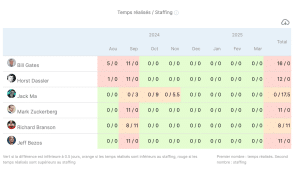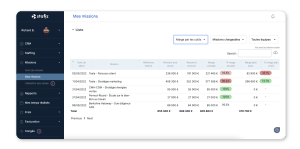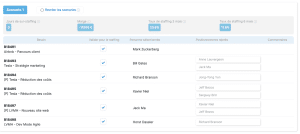How To Avoid Project Deviations?

Most projects face abuses. Time, deliverables, costs or resources: they threaten the success of the project. As a result, understanding the causes of these deviations is essential in order to propose a recovery plan that will save the project.
In this article, we present the different causes of these deviations and present actionable tips to avoid and limit them.
What is a deviation in a project?
A deviation in a project occurs when the project does not follow the expected path. However, a deviation implies that initial objectives have been defined, whether in terms of costs, deadlines or quality. As a result, there are threats to money , time, resource allocation, and deliverables.
Several elements are likely to cause deviations.
- The lack of rigorous preparation, and in particular the lack of clarity of the project specifications. However, this allows the client to define the objectives as well as the scope.
- Lack of anticipation and uncontrolled project risk management .
- Changes in scope , which can have an impact on resources, deadlines and costs.
Alignment gaps with customer objectives
Range deviations endanger a project. Indeed, the scope refers to the tasks to be performed during the project. But sometimes the client's request evolves over the course of the project and the project requires additional deliverables. It is therefore crucial to clearly define the scope and expected deliverables at the project specification stage and then to have them validated in order to limit scope drifts.
This can have an impact:
- on deadlines, sometimes postponing delivery,
- on quality, because the teams are mobilized to ensure that the tasks to be carried out are included in the time initially planned.
- on costs as additional resources may be required.
The main causes of misalignment
Misalignments can occur at different stages of the project.
- During the planning phase: a somewhat vague definition of objectives, imprecise estimates or unrealistic expectations can lead to alignment discrepancies.
- During the execution phase: A change in scope may require a change in resource allocation, either in terms of staff or skills. The use of subcontracting then creates cost drifts.
- During the project: in communication, with the customer or internally, which can create disengagement and a drop in productivity.
How to avoid alignment deviations?
Conduct regular follow-up to identify risks
Avoiding deviations requires attention and responsiveness. It is necessary to monitor the project closely with appropriate indicators and to establish regular communication with both the client and the teams. Setting intermediate milestones regularly helps to limit gaps.
If risks of deviation from the objectives are identified, it is necessary to identify the causes of these delays and to propose solutions, it will then be necessary to arbitrate and prioritize.
Clearly define the scope
One way to avoid alignment drift is to clearly define the scope and scope in the planning phase. Ask questions that will allow you to identify the client's expectations and anticipate anything that could be subject to drift. Then write everything down in the project specifications.
Communicating and contracting
Sometimes, range drifts are inevitable. However, it is important to specify to the customer in advance the impacts in the event of changes : delays, potential additional costs, etc. We recommend that you contract each order with a quote or purchase order signed by the customer in order to protect yourself.

Stafiz offers a framework conducive to contractualization
From the pre-sales stage, manage your quotes and create clear purchase orders for your customers.
The impact of milestones and deliverables on project slippage
Milestones define the major milestones of the project while project deliverables are the renderings ordered by the client. Deliverable deadlines are usually set in advance and can be a way to stagger project billing.
What causes milestones and deliverables to deviate?
The causes of milestone and deliverable drift are generally related to:
- Suboptimal resource management;
- a distorted estimate of skills;
- Inaccurate time estimation, when employees' abilities have been overestimated or when non-billable hours have not been taken into account.
- a delay related to the customer relationship: more back-and-forth than expected, late responses or additional validation steps;
- changes in scope;
- a lack of coordination due to tools that are not adapted or optimised in relation to expectations.
How to anticipate deliverable deviations?
Deliverable drift can be limited by closely observing certain signals: delays, change requests, budget overruns, etc.
If you observe these behaviors, you should seek to identify these causes. Often, this concerns an imprecise initial framing, poor estimates or communication problems.
To anticipate deliverable drifts, frame the project. Establish validation processes with the customer and internally: validation instances or maximum validation times will help you limit deliverable deviations.
Time Goal Derivations
Respecting deadlines remains a key component in the success of a project and is one of the most used criteria for evaluating the performance of an assignment along with respect for costs.
Hence the importance of rigorous monitoring and analyzing the gaps between objectives and reality both at the project level and by day, hour, profile or role. Schedule deviations represent a threat because they often generate cost drift.
What are the causes of time deviations?
Lack of communication
Time objectives must be defined but also communicated to the operational teams so that they can adapt their pace.
Lack of relevance in the choice of indicators to be monitored
Choose carefully which indicators to track. The rest to be done is relevant, for example, because it offers visibility on the times achieved vs. the planned times. On Stafiz, it is also possible to configure preventive alerts for more responsiveness.

Comparison between Actual and Planned Times in Stafiz
Lack of expertise
Strategic decision-making requires a certain level of expertise, especially for budget planning. A less experienced profile does not always have the necessary hindsight to define realistic objectives.
Lack of visibility
A lack of visibility into resource capacity leads to poorly optimized profile selection. A less expert profile than expected then takes longer. However, the allocation of resources is a strategic subject to avoid time drift.
How to avoid time drift?
View History
Rigorous project monitoring helps to limit time drift. On Stafiz, it is possible to access the history of projects in order to observe deviations by type of task or activity.

Reporting of past projects with the possibility of comparison and analysis to understand areas for improvement and mistakes not to be repeated
Compare time spent and time spent
In addition, setting up regular time monitoring is essential, in order to be able to compare planned and actual times. It is then possible to adjust the forecasts if necessary. Stafiz automatically updates the reports every day at midnight, to help you keep track of the progress of projects.

Comparison screen between the times achieved and the times planned in Stafiz.
Establish time limits
On Stafiz, you can limit the recording of times achieved according to the production plan. This prevents employees from entering more time than expected and gives you visibility into the hours worked.
By restricting time entries, teams are incentivized to meet deadlines, thus avoiding time deviations.
Cost and profitability deviations
What are the common causes of cost drift?
Cost and profitability drifts are closely linked to time management. Indeed, a schedule deviation is one of the most common causes of cost overruns.
Difference Between Planning and Delivery
When the planning at the beginning of the project is not accurate, especially in terms of resource allocation, everything must be done to catch up. Often, this results in the use of external service providers or very expert profiles who generate additional costs.
Larger-than-expected expense reports also threaten the project. A project that requires more travel than anticipated in the projected project budget results in additional expenses and cost diversion.
Extended project duration
A long project over several years can be difficult to quantify. Not everything can be accurately anticipated, including price increases or wages, which will impact the overall cost of the project. This can lead to a drift in budgetary objectives.
What are the best practices to avoid cost drift?
While cost drifts are almost impossible to avoid, there are tips to limit their impact.
Tracking costs on landing
Continuous real-time monitoring of landing costs improves profitability visibility and improves accuracy in predictive monitoring.

Rigor in cost monitoring
Rigour helps to avoid cost drifts. Stafiz offers an expense management module as well as a mobile app to be able to record the various costs comprehensively. With a simple photo of the receipt, you can assign them to a specific mission and gain visibility.
Real-time visibility
Finally, visibility on costs and financial status, in real time, allows for better monitoring and reacting in the event of deviations from objectives.
Deviations linked to the occupation of resources
Why is resource allocation often going off the rails?
The allocation of resources is a difficult exercise because it is strategic. As a result, it is common for reality to differ from planning.
Lack of accuracy in load distribution
An overly optimistic view can lead to estimates that are far from reality. A common case is to think that it is possible to carry out a task in-house that ultimately requires outsourcing.
The opposite situation also exists when we imagine that outsourcing will save time. However, when the expected quality is not up to par, it requires additional time internally.
This inaccurate planning leads to additional costs compared to the planned and delays the project. Hence the importance of knowing your resources well, framing the project rigorously and being flexible.
Lock-in situation
This happens when you're already so committed in one direction that it's hard to turn back. So, despite the warning signs, you continue on this path even though the gaps are widening.
How to implement effective resource allocation to reduce time overruns?
The allocation of resources is based on your knowledge of the internal skills, your strengths and weaknesses as well as the project.
Gain visibility
Thus, it is essential to have accurate visibility on the load of your resources, both in the short and long term to be able to anticipate. Controlling the availability of resources is a key issue to avoid project deviations.
Anticipating scenarios
To help you set up an efficient resource allocation , you can use tools. Stafiz offers a scenario builder feature that can generate different scenarios based on different criteria such as the most profitable or fastest scenario.

This tool makes it possible to present scenarios that would not have been considered, or even more pessimistic, which makes it possible to better anticipate risks.
A project that drifts may not be profitable. Avoiding lens drift is therefore essential. It is therefore necessary to try to understand the causes of these deviations. Often, this is an incorrect initial estimate, an illustration of a lack of experience, even if unexpected internal or external factors may arise.
To avoid deviations from objectives in a project, careful preparation is therefore essential. However, sometimes some projects cannot be saved or all initial expectations cannot be met. In any case, drawing up a project assessment is essential because it allows you to take stock and is a valuable background for future projects.
Questions:
A slippage corresponds to a significant gap between what is planned and what has been achieved, whether in terms of time, cost or scope. It is often the result of a lack of anticipation, communication or follow-up. Rigorous governance and regular reporting are the best weapons to control them.
Drifts are prevented by precise framing, realistic planning and regular monitoring of key indicators. Frequent milestones, transparent communication, and clear risk management help anticipate deviations before they become critical.
Track costs in real-time and compare them to the initial budget. Identify at-risk positions and adjust priorities or resources at the first deviations. The use of a project financial management tool facilitates continuous monitoring and reinforces responsiveness in the face of deviations.
Immediately analyze the impact on deadlines, costs, and deliverables, then formalize a change request. Have this evolution validated by the sponsor or client before any implementation, in order to preserve the contractual balance and the traceability of the project.


